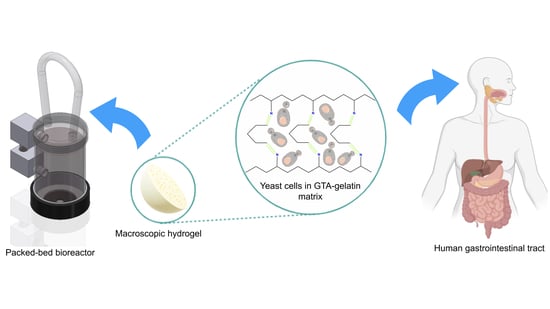Formulation and Characterization of Gelatin-Based Hydrogels for the Encapsulation of Kluyveromyces lactis—Applications in Packed-Bed Reactors and Probiotics Delivery in Humans
Abstract
1. Introduction
2. Materials and Methods
2.1. Microorganisms and Culture Media
2.2. Preparation of Gelatin Hydrogels
2.3. Probiotic Encapsulation
2.4. Experimental Design
2.5. Survival Rate of Encapsulated Probiotics
2.6. Morphological Structure and Beads Conformation
2.7. Spectroscopy Analyses
2.8. Swelling Percentage Determination
2.9. Rheological Response
2.10. Thermal Stability Analyses
2.11. Mechanical Resistance Evaluation
2.12. Performance of Encapsulates in a Milliliter Scale Bioreactor
2.13. Chromatography Analysis
2.14. Performance of Encapsulates in the Simulated Gastrointestinal Tract Media
3. Results and Discussion
3.1. Morphological Structure and Cells Encapsulated
3.2. Functional Groups Identification
3.3. Hydrogels Swelling Degree
3.4. Hydrogels Rheological Behavior
3.5. Mechanical Resistance Evaluation
3.6. Thermal Resistance Evaluation
3.7. Proof-of-Concept: Milli-Bioreactor Operation
3.8. Cell Viability Assays
4. Conclusions
Supplementary Materials
Author Contributions
Funding
Acknowledgments
Conflicts of Interest
References
- Hasler, C.M. Functional foods: Benefits, concerns and challenges—A position paper from the American council on science and health. J. Nutr. 2002, 132, 3772–3781. [Google Scholar] [CrossRef]
- Onwulata, C.I. Encapsulation of New Active Ingredients. Annu. Rev. Food Sci. Technol. 2012, 3, 183–202. [Google Scholar] [CrossRef]
- Dafe, A.; Etemadi, H.; Dilmaghani, A.; Mahdavinia, G.R. Investigation of pectin/starch hydrogel as a carrier for oral delivery of probiotic bacteria. Int. J. Boil. Macromol. 2017, 97, 536–543. [Google Scholar] [CrossRef]
- Dong, Q.-Y.; Chen, M.-Y.; Xin, Y.; Qin, X.-Y.; Cheng, Z.; Shi, L.-E.; Tang, Z.-X. Alginate-based and protein-based materials for probiotics encapsulation: A review. Int. J. Food Sci. Technol. 2013, 48, 1339–1351. [Google Scholar] [CrossRef]
- Williams, N.T. Probiotics. Am. J. Health Pharm. 2010, 67, 449–458. [Google Scholar] [CrossRef]
- Amidon, G.E.; Peck, G.E.; Block, L.H.; Moreton, R.C.; Katdare, A.; Lafaver, R.; Sheehan, C. Proposed new USP general information chapter, excipient performance. Pharmacop. Forum 2007, 33, 1311–1323. [Google Scholar]
- Sreeja, V.; Prajapati, J.B. Probiotic Formulations: Application and Status as Pharmaceuticals—A Review. Probiotics Antimicrob. Proteins 2013, 5, 81–91. [Google Scholar] [CrossRef]
- Gu, M.; Zhang, Z.; Pan, C.; Goulette, T.R.; Zhang, R.; Hendricks, G.; McClements, D.J.; Xiao, H. Encapsulation of Bifidobacterium pseudocatenulatum G7 in gastroprotective microgels: Improvement of the bacterial viability under simulated gastrointestinal conditions. Food Hydrocoll. 2019, 91, 283–289. [Google Scholar] [CrossRef]
- Afzaal, M.; Khan, A.U.; Saeed, F.; Arshad, M.S.; Khan, M.A.; Saeed, M.; Maan, A.A.; Khan, M.K.; Ismail, Z.; Ahmed, A.; et al. Survival and stability of free and encapsulated probiotic bacteria under simulated gastrointestinal conditions and in ice cream. Food Sci. Nutr. 2020, 8, 1649–1656. [Google Scholar] [CrossRef]
- Da Silva, B.V.; Barreira, J.C.M.; Oliveira, M.B.P.P. Natural phytochemicals and probiotics as bioactive ingredients for functional foods: Extraction biochemistry and protected-delivery technologies. Trends Food Sci. Technol. 2016, 50, 144–158. [Google Scholar] [CrossRef]
- Fang, Z.; Bhandari, B. Spray drying freeze drying and related processes for food ingredient and nutraceutical encapsulation. In Encapsulation Technologies and Delivery Systems for Food Ingredients and Nutraceuticals; Elsevier: Amsterdam, The Netherlands, 2012; pp. 73–109. [Google Scholar]
- Li, Y.; Feng, C.; Li, J.; Mu, Y.; Liu, Y.; Kong, M.; Cheng, X.; Chen, X. Construction of multilayer alginate hydrogel beads for oral delivery of probiotics cells. Int. J. Boil. Macromol. 2017, 105, 924–930. [Google Scholar] [CrossRef] [PubMed]
- Sáez, V.; Hernáez, E.; Sanz, L. Hydrogels Controled Drug Release. Ibero-Am. J. Polym. 2003, 4, 21–91. [Google Scholar]
- Piao, Y.; Chen, B. Synthesis and mechanical properties of double cross-linked gelatin-graphene oxide hydrogels. Int. J. Boil. Macromol. 2017, 101, 791–798. [Google Scholar] [CrossRef]
- Rose, J.; Pacelli, S.; Haj, A.; Dua, H.; Hopkinson, A.; White, L.; Rose, F. Gelatin-Based Materials in Ocular Tissue Engineering. Materials 2014, 7, 3106–3135. [Google Scholar] [CrossRef]
- Mishra, S.; Scarano, F.J.; Calvert, P. Entrapment of Saccharomyces cerevisiaeand 3T3 fibroblast cells into blue light cured hydrogels. J. Biomed. Mater. Res. Part A 2012, 100A, 2829–2838. [Google Scholar] [CrossRef]
- Rabanel, J.-M.; Banquy, X.; Zouaoui, H.; Mokhtar, M.; Hildgen, P. Progress technology in microencapsulation methods for cell therapy. Biotechnol. Prog. 2009, 25, 946–963. [Google Scholar] [CrossRef]
- Akdemir, Z.S.; Kayaman-Apohan, N.; Kahraman, M.V.; Kuruca, S.E.; Güngör, A.; Karadenizli, S. Preparation of Biocompatible UV-Cured Fumarated Poly(ether-ester)-Based Tissue-Engineering Hydrogels. J. Biomater. Sci. Polym. Ed. 2011, 22, 857–872. [Google Scholar] [CrossRef]
- Song, K.; Qiao, M.; Liu, T.; Jiang, B.; Macedo, H.M.; Ma, X.; Cui, Z. Preparation fabrication and biocompatibility of novel injectable temperature-sensitive chitosan/glycerophosphate/collagen hydrogels. J. Mater. Sci. Mater. Electron. 2010, 21, 2835–2842. [Google Scholar] [CrossRef]
- Liu, Y.; Charles, L.F.; Zarembinski, T.I.; Johnson, K.I.; Atzet, S.K.; Wesselschmidt, R.L.; Wight, M.E.; Kuhn, L.T. Modified Hyaluronan Hydrogels Support the Maintenance of Mouse Embryonic Stem Cells and Human Induced Pluripotent Stem Cells. Macromol. Biosci. 2012, 12, 1034–1042. [Google Scholar] [CrossRef]
- Trimaille, T.; Pertici, V.; Gigmes, D. Recent advances in synthetic polymer based hydrogels for spinal cord repair. C. R. Chim. 2016, 19, 157–166. [Google Scholar] [CrossRef]
- Sohail, M.; Minhas, M.U.; Khan, S.; Hussain, Z.; de Matas, M.; Shah, S.A.; Khan, S.; Kousar, M.; Ullah, K. Natural and synthetic polymer-based smart biomaterials for management of ulcerative colitis: A review of recent developments and future prospects. Drug Deliv. Transl. Res. 2018, 9, 595–614. [Google Scholar] [CrossRef]
- Aravamudhan, A.; Ramos, D.M.; Nada, A.A.; Kumbar, S.G. Natural Polymers: Polysaccharides and Their Derivatives for Biomedical Applications. In Natural and Synthetic Biomedical Polymers; Elsevier: Amsterdam, The Netherlands, 2014; pp. 67–89. [Google Scholar]
- Yu, L.; Gu, L. Effects of microstructure crosslinking density, temperature and exterior load on dynamic pH-response of hydrolyzed polyacrylonitrile-blend-gelatin hydrogel fibers. Eur. Polym. J. 2009, 45, 1706–1715. [Google Scholar] [CrossRef]
- Liu, H.; Rong, L.; Wang, B.; Xie, R.; Sui, X.; Xu, H.; Zhang, L.; Zhong, Y.; Mao, Z. Facile fabrication of redox/pH dual stimuli responsive cellulose hydrogel. Carbohydr. Polym. 2017, 176, 299–306. [Google Scholar] [CrossRef]
- Haq, M.A.; Su, Y.; Wang, D. Mechanical properties of PNIPAM based hydrogels: A review. Mater. Sci. Eng. C 2017, 70, 842–855. [Google Scholar] [CrossRef]
- Oommen, O.P.; Wang, S.; Kisiel, M.; Sloff, M.; Hilborn, J.; Varghese, O.P. Smart Design of Stable Extracellular Matrix Mimetic Hydrogel: Synthesis Characterization, and In Vitro and In Vivo Evaluation for Tissue Engineering. Adv. Funct. Mater. 2012, 23, 1273–1280. [Google Scholar] [CrossRef]
- Negrini, N.C.; Tarsini, P.; Tanzi, M.C.; Farè, S. Chemically crosslinked gelatin hydrogels as scaffolding materials for adipose tissue engineering. J. Appl. Polym. Sci. 2018, 136, 47104. [Google Scholar] [CrossRef]
- Serna, J.; Florez, S.; Talero, V.; Briceño, J.; Muñoz-Camargo, C.; Cruz, J. Formulation and Characterization of a SIS-Based Photocrosslinkable Bioink. Polymers 2019, 11, 569. [Google Scholar] [CrossRef]
- Huerta-Angeles, G.; Hishchak, K.; Strachota, A.; Strachota, B.; Šlouf, M.; Matějka, L. Super-porous nanocomposite PNIPAm hydrogels reinforced with titania nanoparticles displaying a very fast temperature response as well as pH-sensitivity. Eur. Polym. J. 2014, 59, 341–352. [Google Scholar] [CrossRef]
- Smith, M.J.; Francis, M.B. Improving metabolite production in microbial co-cultures using a spatially constrained hydrogel. Biotechnol. Bioeng. 2017, 114, 1195–1200. [Google Scholar] [CrossRef]
- Spizzirri, U.G.; Curcio, M.; Cirillo, G.; Picci, N.; Nicoletta, F.P.; Iemma, F. Functional hydrogels with a multicatalytic activity for bioremediation: Single-step preparation and characterization. J. Appl. Polym. Sci. 2016, 133. [Google Scholar] [CrossRef]
- Ercan, D.; Demirci, A. Effects of fed-batch and continuous fermentations on human lysozyme production by Kluyveromyces lactis K7 in biofilm reactors. Bioprocess Biosyst. Eng. 2015, 38, 2461–2468. [Google Scholar] [CrossRef]
- Sumeri, I.; Arike, L.; Adamberg, K.; Paalme, T. Single bioreactor gastrointestinal tract simulator for study of survival of probiotic bacteria. Appl. Microbiol. Biotechnol. 2008, 80, 317–324. [Google Scholar] [CrossRef]
- Song, H.-J.; Li, H.; Seo, J.-H.; Kim, M.-J.; Kim, S.-J. Pilot-scale production of bacterial cellulose by a spherical type bubble column bioreactor using saccharified food wastes. Korean J. Chem. Eng. 2009, 26, 141–146. [Google Scholar] [CrossRef]
- Rasoulnia, P.; Mousavi, S.M. Maximization of organic acids production by Aspergillus niger in a bubble column bioreactor for V and Ni recovery enhancement from power plant residual ash in spent-medium bioleaching experiments. Bioresour. Technol. 2016, 216, 729–736. [Google Scholar] [CrossRef]
- Chu, C.-Y.; Wu, S.-Y.; Shen, Y.-C. Biohydrogen production performance in a draft tube bioreactor with immobilized cell. Int. J. Hydrogen Energy 2012, 37, 15658–15665. [Google Scholar] [CrossRef]
- Yoshimoto, M.; Li, C.; Matsunaga, T.; Nakagawa, H.; Fukunaga, K.; Nakao, K. Optimal Preparation of Immobilized Liposome-Bound Cellulase for Hydrolysis of Insoluble Cellulose in an External Loop Airlift Bioreactor. Biotechnol. Prog. 2006, 22, 459–464. [Google Scholar] [CrossRef]
- Inal, M.; Yiğitoğlu, M. Production of bioethanol by immobilized Saccharomyces Cerevisiae onto modified sodium alginate gel. J. Chem. Technol. Biotechnol. 2011, 86, 1548–1554. [Google Scholar] [CrossRef]
- Patel, M.; Bassi, A.S.; Zhu, J.J.-X.; Gomaa, H. Investigation of a dual-particle liquid-solid circulating fluidized bed bioreactor for extractive fermentation of lactic acid. Biotechnol. Prog. 2008, 24, 821–831. [Google Scholar] [CrossRef]
- Sevillano, X.; Isasi, J.R.; Peñas, F.J. Performance of a fluidized-bed bioreactor with hydrogel biomass carrier under extremely low-nitrogen availability and effect of nitrogen amendments. J. Chem. Technol. Biotechnol. 2011, 87, 402–409. [Google Scholar] [CrossRef]
- Pakdel, P.M.; Peighambardoust, S.J. A review on acrylic based hydrogels and their applications in wastewater treatment. J. Environ. Manag. 2018, 217, 123–143. [Google Scholar] [CrossRef]
- Arunraj, B.; Talasila, S.; Rajesh, V.; Rajesh, N. Removal of Europium from aqueous solution using Saccharomyces cerevisiae immobilized in glutaraldehyde cross-linked chitosan. Sep. Sci. Technol. 2018, 54, 1620–1631. [Google Scholar]
- Goldenstedt, C.; Birer, A.; Cathignol, D.; Chesnais, S.; Bahri, Z.E.; Massard, C.; Taverdet, J.-L.; Lafon, C. Delivery by shock waves of active principle embedded in gelatin-based capsules. Ultrason. Sonochem. 2008, 15, 808–814. [Google Scholar] [CrossRef] [PubMed]
- Kommareddy, S.; Amiji, M. Poly(ethylene glycol)modified thiolated gelatin nanoparticles for glutathione-responsive intracellular DNA delivery. Nanomed. Nanotechnol. Biol. Med. 2007, 3, 32–42. [Google Scholar] [CrossRef] [PubMed]
- Thimma, R.T.; Tammishetti, S. Study of complex coacervation of gelatin with sodium carboxymethyl guar gum: Microencapsulation of clove oil and sulphamethoxazole. J. Microencapsul. 2003, 20, 203–210. [Google Scholar] [CrossRef]
- Li, X.; Chen, S.; Li, J.; Wang, X.; Zhang, J.; Kawazoe, N.; Chen, G. 3D Culture of Chondrocytes in Gelatin Hydrogels with Different Stiffness. Polymers 2016, 8, 269. [Google Scholar] [CrossRef]
- Abreu, D. Study of the Effect of the Degree of Crosslinking of Electro-Spun Gelatin on its Resistance to Degradation. Master’s Thesis, Yucatan Scientific Research Center, Merida, Yucatan, Mexico, 2017. [Google Scholar]
- Shah, N.P.; Cruz, A.G.; Faria, J.D. Probiotic and Prebiotic Foods: Technology, Stability and Benefits to Human Health; Nova Science Publishers: New York, NY, USA, 2011. [Google Scholar]
- Galdeano, C.M.; Dogi, C.A.; Bonet, M.E.B.; de Moreno de LeBlanc, A.; Perdigón, G. Probiotic Bacteria as Mucosal Immune System Adjuvants. In Bioactive Food as Dietary Interventions for Liver and Gastrointestinal Disease; Elsevier: Amsterdam, The Netherlands, 2013; pp. 285–299. [Google Scholar]
- Van Ooyen, A.J.J.; Dekker, P.; Huang, M.; Olsthoorn, M.M.A.; Jacobs, D.I.; Colussi, P.A.; Taron, C.H. Heterologous protein production in the yeast Kluyveromyces lactis. FEMS Yeast Res. 2006, 6, 381–392. [Google Scholar] [CrossRef] [PubMed]
- Hsieh, H.B.; Da Silva, N.A. Development of a LAC4 promoter-based gratuitous induction system in Kluyveromyces lactis. Biotechnol. Bioeng. 2000, 67, 408–416. [Google Scholar] [CrossRef]
- Rodicio, R.; Heinisch, J.J. Yeast on the milky way: Genetics physiology and biotechnology of Kluyveromyces lactis. Yeast 2013, 30, 165–177. [Google Scholar] [CrossRef]
- Spohner, S.C.; Schaum, V.; Quitmann, H.; Czermak, P. Kluyveromyces lactis: An emerging tool in biotechnology. J. Biotechnol. 2016, 222, 104–116. [Google Scholar] [CrossRef]
- Guluarte, C.; Reyes-Becerril, M.; Gonzalez-Silvera, D.; Cuesta, A.; Angulo, C.; Esteban, M. Ángeles Probiotic properties and fatty acid composition of the yeast Kluyveromyces lactis M3. In vivo immunomodulatory activities in gilthead seabream (Sparus aurata). Fish Shellfish Immunol. 2019, 94, 389–397. [Google Scholar] [CrossRef]
- Dias, O.; Pereira, R.; Gombert, A.K.; Ferreira, E.C.; Rocha, I. iOD907 the first genome-scale metabolic model for the milk yeast Kluyveromyces lactis. Biotechnol. J. 2014, 9, 776–790. [Google Scholar] [CrossRef] [PubMed]
- Lee, H.-M.; Park, S.-W.; Lee, S.-J.; Kong, K.-H. Optimized production and quantification of the tryptophan-deficient sweet-tasting protein brazzein in Kluyveromyces lactis. Prep. Biochem. Biotechnol. 2019, 49, 790–799. [Google Scholar] [CrossRef] [PubMed]
- Shekhtman, A.; Burz, D.S. (Eds.) Protein NMR Techniques; Humana Press: Totowa, NJ, USA, 2012. [Google Scholar]
- Tian, Z.; Duan, L.; Wu, L.; Shen, L.; Li, G. Rheological properties of glutaraldehyde-crosslinked collagen solutions analyzed quantitatively using mechanical models. Mater. Sci. Eng. C 2016, 63, 10–17. [Google Scholar] [CrossRef] [PubMed]
- Rivas-Morales, C.; Oranday-Cárdenas, M.A.; Verde-Star, M.J. Investigación en Plantas de Importancia Médica; OmniaScience: Barcelona, Spain, 2016. [Google Scholar]
- Schindelin, J.; Arganda-Carreras, I.; Frise, E.; Kaynig, V.; Longair, M.; Pietzsch, T.; Preibisch, S.; Rueden, C.; Saalfeld, S.; Schmid, B.; et al. Fiji: An open-source platform for biological-image analysis. Nat. Methods 2012, 9, 676–682. [Google Scholar] [CrossRef]
- Schneider, C.A.; Rasband, W.S.; Eliceiri, K.W. NIH Image to ImageJ: 25 years of image analysis. Nat. Methods 2012, 9, 671–675. [Google Scholar] [CrossRef]
- Comportamiento reológico de geles biodegradables para aplicacions en medicina regenerativa. Biomecánica 2012, 20, 4664.
- Chen, X.; Fan, M.; Tan, H.; Ren, B.; Yuan, G.; Jia, Y.; Li, J.; Xiong, D.; Xing, X.; Niu, X.; et al. Magnetic and self-healing chitosan-alginate hydrogel encapsulated gelatin microspheres via covalent cross-linking for drug delivery. Mater. Sci. Eng. C 2019, 101, 619–629. [Google Scholar] [CrossRef]
- Gonzalez, L.P. Development and Physical, Chemical and Mechanical Characterization of a Chitosan-based Compound with Potential Use as a Bone Adhesive. Master’s Thesis, Los Andes University, Bogotá, Colombia, 2016. [Google Scholar]
- Suriñach, S.; Baro, M.; Bordas, S.; Clavaguera, N.; Clavaguera-Mora, M. Differential scanning calorimetry and its application to materials science. Bull. Span. Ceram. Glass Soc. 1992, 31, 11–17. [Google Scholar]
- Li, P.; Zhang, J.; Sun, S.-H.; Xie, J.-P.; Zong, Y.-L. A novel model mouth system for evaluation of In Vitro release of nicotine from moist snuff. Chem. Cent. J. 2013, 7, 176. [Google Scholar] [CrossRef]
- Klein, S. The Use of Biorelevant Dissolution Media to Forecast the In Vivo Performance of a Drug. AAPS J. 2010, 12, 397–406. [Google Scholar] [CrossRef]
- Yuan, L.; Wu, Y.; Gu, Q.-S.; El-Hamshary, H.; El-Newehy, M.; Mo, X. Injectable photo crosslinked enhanced double-network hydrogels from modified sodium alginate and gelatin. Int. J. Boil. Macromol. 2017, 96, 569–577. [Google Scholar] [CrossRef] [PubMed]
- Eichler, S.; Ramon, O.; Cohen, Y.; Mizrahi, S. Swelling and contraction driven mass transfer processes during osmotic dehydration of uncharged hydrogels. Int. J. Food Sci. Technol. 2002, 37, 245–253. [Google Scholar] [CrossRef]
- Hagel, V.; Haraszti, T.; Boehm, H. Diffusion and interaction in PEG-DA hydrogels. Biointerphases 2013, 8, 36. [Google Scholar] [CrossRef] [PubMed]
- Perpetuini, G.; Tittarelli, F.; Suzzi, G.; Tofalo, R. Cell Wall Surface Properties of Kluyveromyces marxianus Strains from Dairy-Products. Front. Microbiol. 2019, 10, 79. [Google Scholar] [CrossRef] [PubMed]
- Ibrahim, M.; Mahmoud, A.A.; Osman, O.; El-Aal, M.A.; Eid, M. Molecular spectroscopic analyses of gelatin. Spectrochim. Acta Part A Mol. Biomol. Spectrosc. 2011, 81, 724–729. [Google Scholar] [CrossRef] [PubMed]
- De Campos Vidal, B.; Mello, M.L.S. Collagen type I amide I band infrared spectroscopy. Micron 2011, 42, 283–289. [Google Scholar] [CrossRef]
- Si, L.; Fan, Y.; Wang, Y.; Sun, L.; Li, B.; Xue, C.; Hou, H. Thermal degradation behavior of collagen from sea cucumber (Stichopus japonicus) using TG-FTIR analysis. Thermochim. Acta 2018, 659, 166–171. [Google Scholar] [CrossRef]
- Castillo Martínez, M. Aplicación de la Espectroscopia NIR al Control Analítico de Procesos de la Industria Química. Ph.D. Thesis, Universitat Autónoma de Barcelona, Barcelona, Spain, 2007. [Google Scholar]
- Peguero Gutierrez, A. NIR Spectroscopy in the Determination of Physical Properties and Chemical Composition of Production Intermediates and Finished Products. Ph.D. Thesis, Universidad Autonoma de Barcelona, Barcelona, Spain, 2010. [Google Scholar]
- Duconseille, A.; Andueza, D.; Picard, F.; Santé-Lhoutellier, V.; Astruc, T. Molecular changes in gelatin aging observed by NIR and fluorescence spectroscopy. Food Hydrocoll. 2016, 61, 496–503. [Google Scholar] [CrossRef]
- Qiao, C.; Cao, X.; Wang, F. Swelling Behavior Study of Physically Crosslinked Gelatin Hydrogels. Polym. Polym. Compos. 2012, 20, 53–58. [Google Scholar] [CrossRef]
- Bukhari, S.M.H.; Khan, S.; Rehanullah, M.; Ranjha, N.M. Synthesis and Characterization of Chemically Cross-Linked Acrylic Acid/Gelatin Hydrogels: Effect of pH and Composition on Swelling and Drug Release. Int. J. Polym. Sci. 2015, 2015, 1–15. [Google Scholar] [CrossRef]
- Xu, Y.; Wu, Q.; Sun, Y.; Bai, H.; Shi, G. Three-Dimensional Self-Assembly of Graphene Oxide and DNA into Multifunctional Hydrogels. ACS Nano 2010, 4, 7358–7362. [Google Scholar] [CrossRef] [PubMed]
- Alsarra, I.A.; Hamed, A.Y.; Alanazi, F.K.; Neau, S.H. Rheological and mucoadhesive characterization of poly(vinylpyrrolidone) hydrogels designed for nasal mucosal drug delivery. Arch. Pharmacal Res. 2011, 34, 573–582. [Google Scholar] [CrossRef] [PubMed]
- Mun, S.; Park, S.; Kim, Y.-R.; McClements, D.J. Influence of methylcellulose on attributes of β-carotene fortified starch-based filled hydrogels: Optical rheological, structural, digestibility, and bioaccessibility properties. Food Res. Int. 2016, 87, 18–24. [Google Scholar] [CrossRef] [PubMed]
- Williams, P.D.; Oztop, M.H.; McCarthy, M.J.; McCarthy, K.L.; Lo, Y.M. Characterization of Water Distribution in Xanthan-Curdlan Hydrogel Complex Using Magnetic Resonance Imaging Nuclear Magnetic Resonance Relaxometry, Rheology, and Scanning Electron Microscopy. J. Food Sci. 2011, 76, E472–E478. [Google Scholar] [CrossRef]
- Pitarresi, G.; Giacomazza, D.; Triolo, D.; Giammona, G.; Biagio, P.L.S. Rheological characterization and release properties of inulin-based hydrogels. Carbohydr. Polym. 2012, 88, 1033–1040. [Google Scholar] [CrossRef]
- Fallon; Halligan; Pezzoli; Geever; Higginbotham Synthesis and Characterisation of Novel Temperature and pH Sensitive Physically Cross-Linked Poly (N-vinylcaprolactam-co-itaconic Acid) Hydrogels for Drug Delivery. Gels 2019, 5, 41. [CrossRef]
- Tresoldi, C.; Pacheco, D.P.; Formenti, E.; Pellegata, A.F.; Mantero, S.; Petrini, P. Shear-resistant hydrogels to control permeability of porous tubular scaffolds in vascular tissue engineering. Mater. Sci. Eng. C 2019, 105, 110035. [Google Scholar] [CrossRef]
- Stojkovska, J.; Bugarski, B.; Obradovic, B. Evaluation of alginate hydrogels under in vivolike bioreactor conditions for cartilage tissue engineering. J. Mater. Sci. Mater. Electron. 2010, 21, 2869–2879. [Google Scholar] [CrossRef]
- Lohbauer, U.; Muller, F.; Petschelt, A. Influence of surface roughness on mechanical strength of resin composite versus glass ceramic materials. Dent. Mater. 2008, 24, 250–256. [Google Scholar] [CrossRef]
- Mi, S.; Khutoryanskiy, V.V.; Jones, R.R.; Zhu, X.; Hamley, I.W.; Connon, C.J. Photochemical cross-linking of plastically compressed collagen gel produces an optimal scaffold for corneal tissue engineering. J. Biomed. Mater. Res. Part A 2011, 99A, 1–8. [Google Scholar] [CrossRef] [PubMed]
- Markov, P.A.; Krachkovsky, N.S.; Durnev, E.A.; Martinson, E.A.; Litvinets, S.G.; Popov, S.V. Mechanical properties structure, bioadhesion, and biocompatibility of pectin hydrogels. J. Biomed. Mater. Res. Part A 2017, 105, 2572–2581. [Google Scholar] [CrossRef] [PubMed]
- Guo, J.; Ge, L.; Li, X.; Mu, C.; Li, D. Periodate oxidation of xanthan gum and its crosslinking effects on gelatin-based edible films. Food Hydrocoll. 2014, 39, 243–250. [Google Scholar] [CrossRef]
- Rodríguez-Rodríguez, R.; García-Carvajal, Z.Y.; Jiménez-Palomar, I.; Jiménez-Avalos, J.A.; Espinosa-Andrews, H. Development of gelatin/chitosan/PVA hydrogels: Thermal stability water state, viscoelasticity, and cytotoxicity assays. J. Appl. Polym. Sci. 2018, 136, 47149. [Google Scholar] [CrossRef]
- Eid, M.; Abdel-Ghaffar, M.A.; Dessouki, A.M. Effect of maleic acid content on the thermal stability swelling behaviour and network structure of gelatin-based hydrogels prepared by gamma irradiation. Nucl. Instrum. Methods Phys. Res. Sect. B Beam Interact. Mater. Atoms. 2009, 267, 91–98. [Google Scholar] [CrossRef]
- Zeiger, E.; Gollapudi, B.; Spencer, P. Genetic toxicity and carcinogenicity studies of glutaraldehyde?a review. Mutat. Res. Mutat. Res. 2005, 589, 136–151. [Google Scholar] [CrossRef] [PubMed]
- Rathna, G.V.N. Gelatin hydrogels: Enhanced biocompatibility drug release and cell viability. J. Mater. Sci. Mater. Electron. 2007, 19, 2351–2358. [Google Scholar] [CrossRef] [PubMed]
- Peng, Z.; Peng, Z.; Shen, Y. Fabrication and Properties of Gelatin/Chitosan Composite Hydrogel. Polym. Technol. Eng. 2011, 50, 1160–1164. [Google Scholar] [CrossRef]

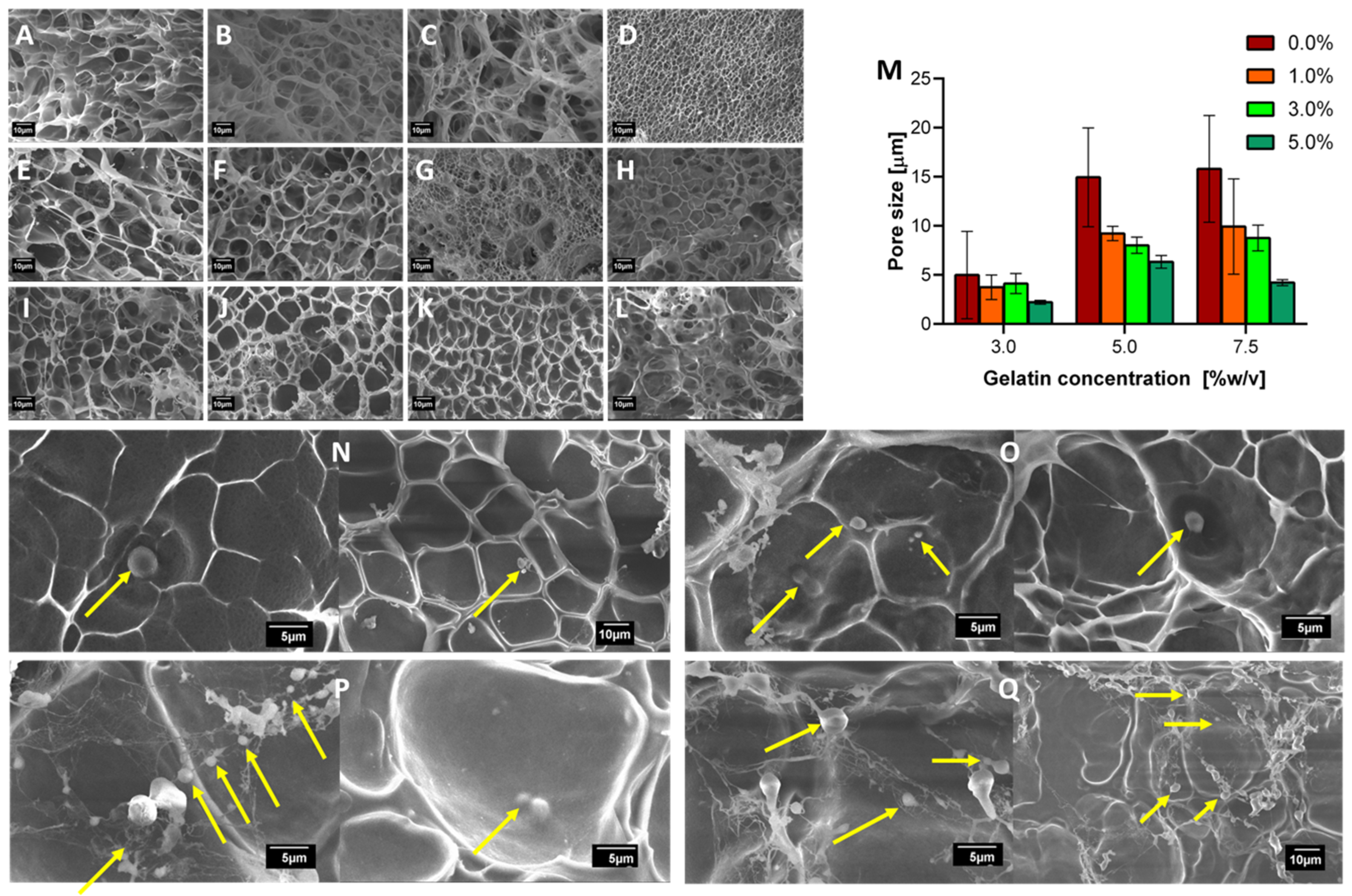
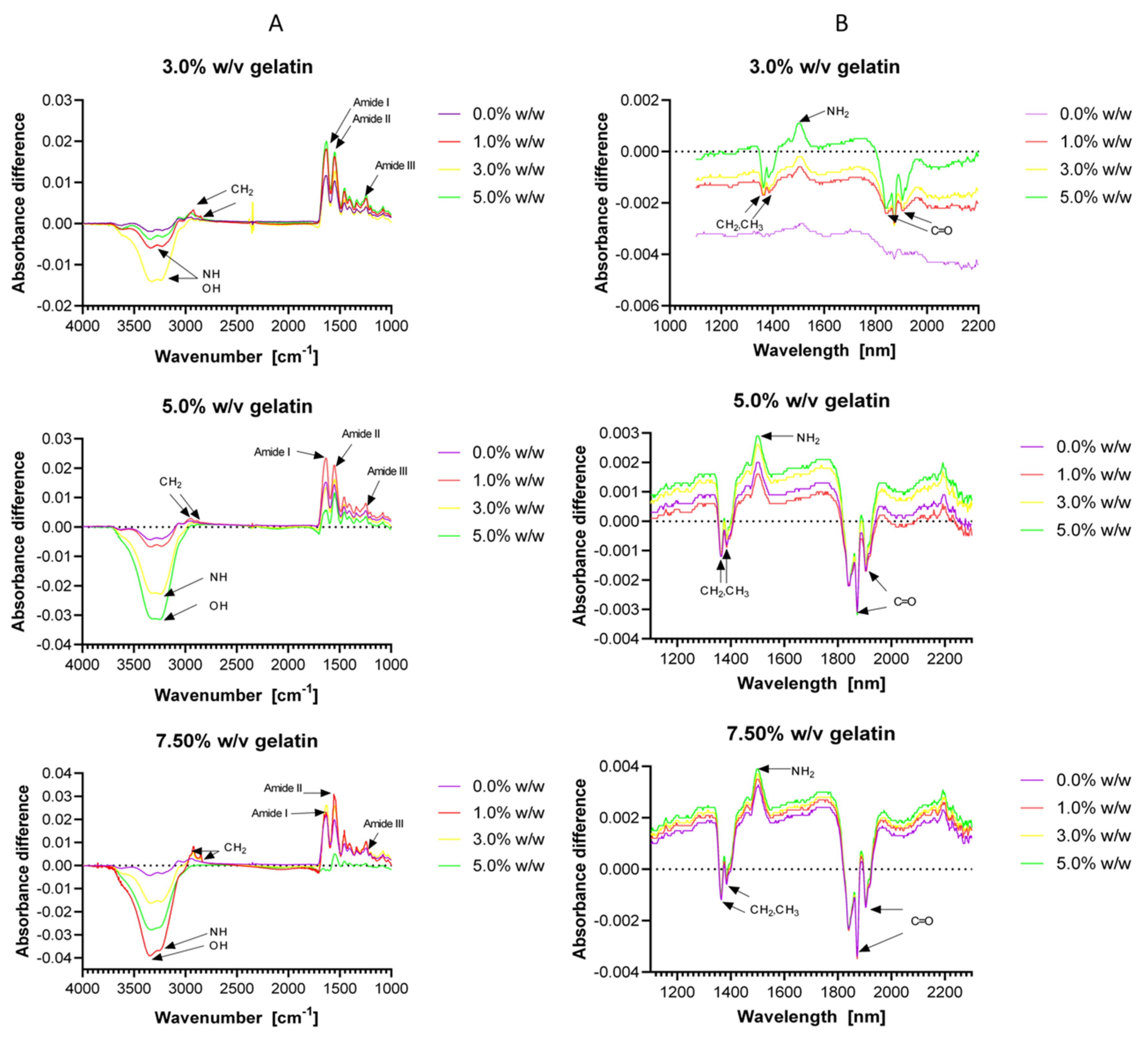




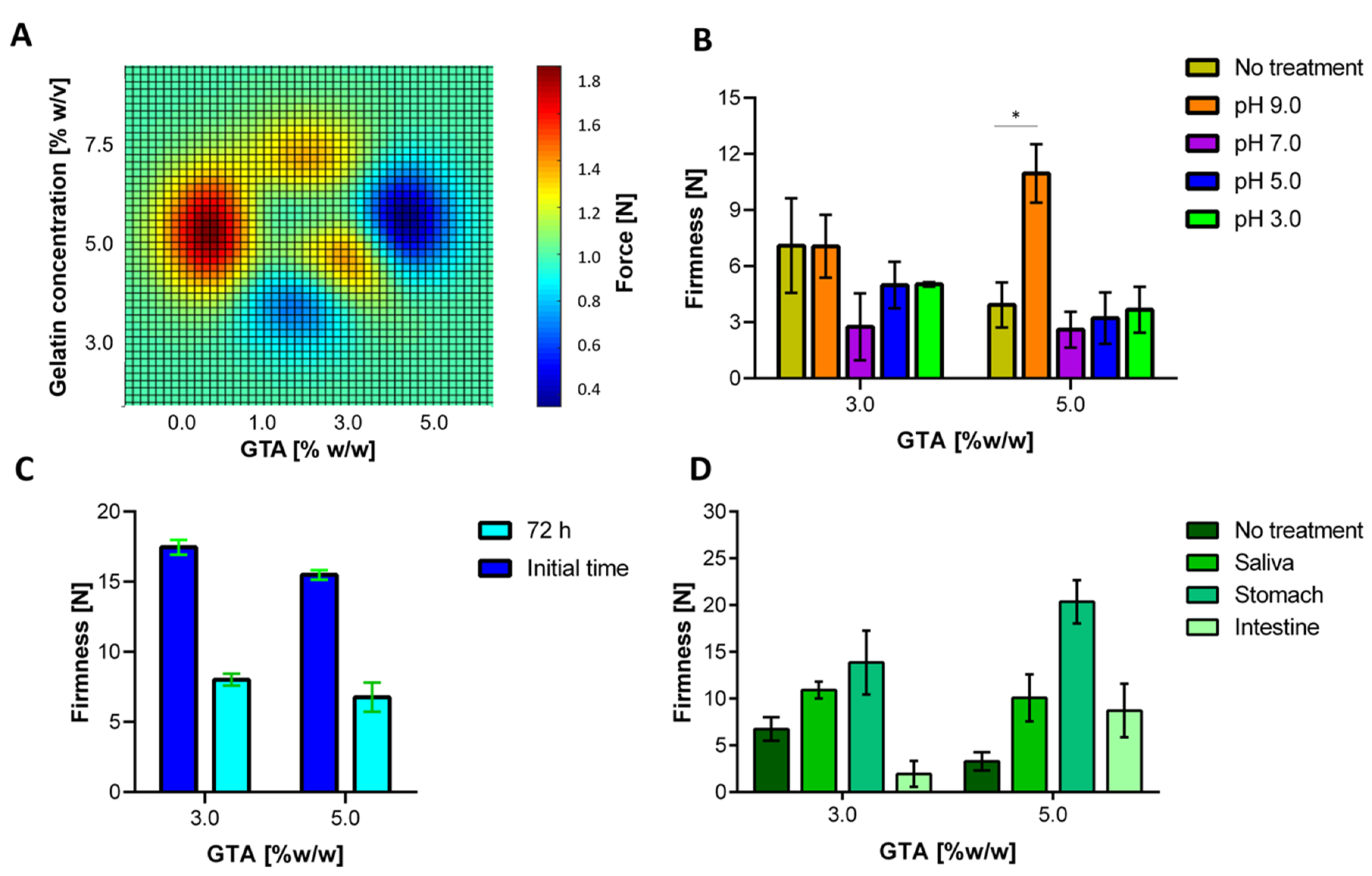
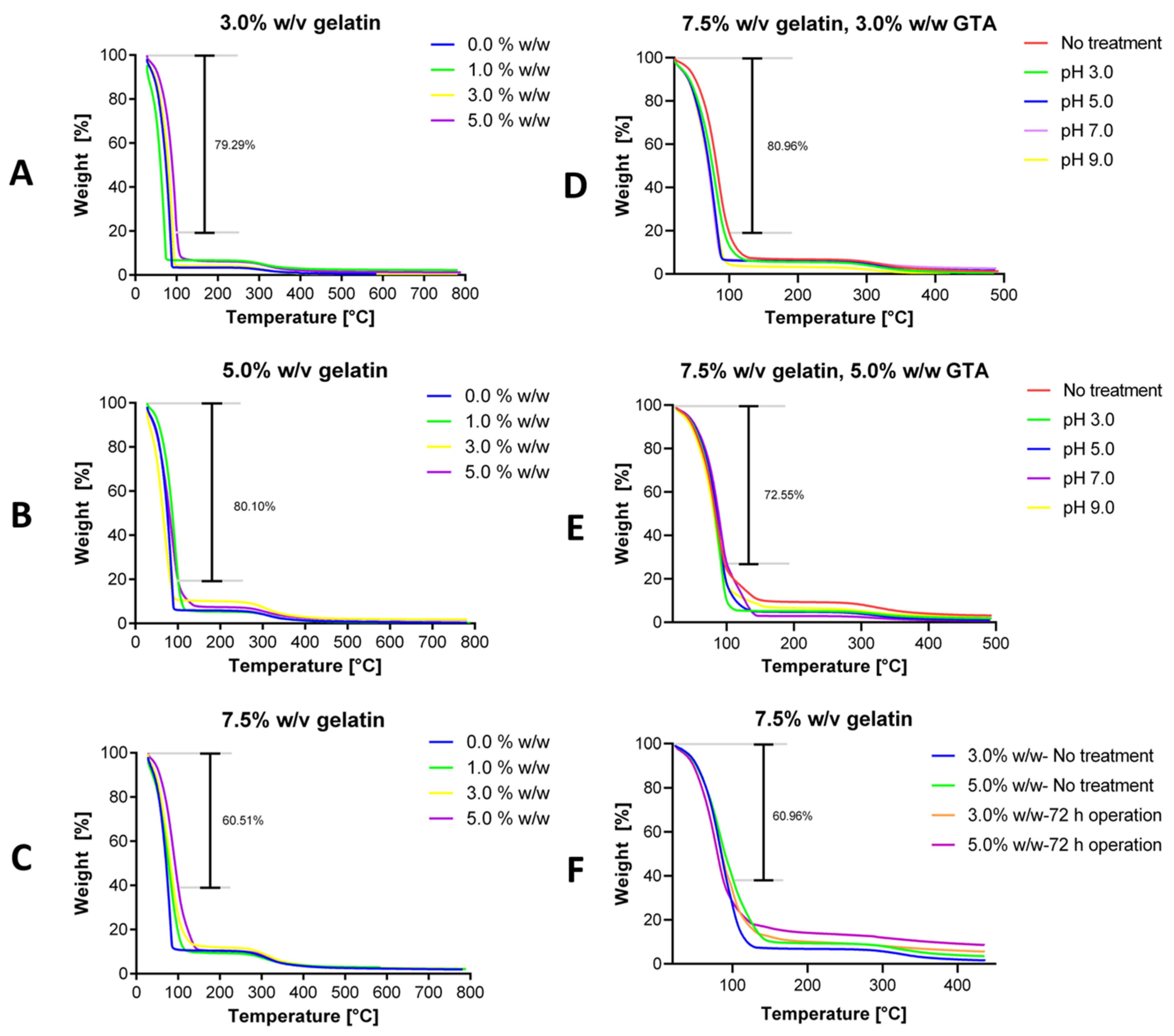
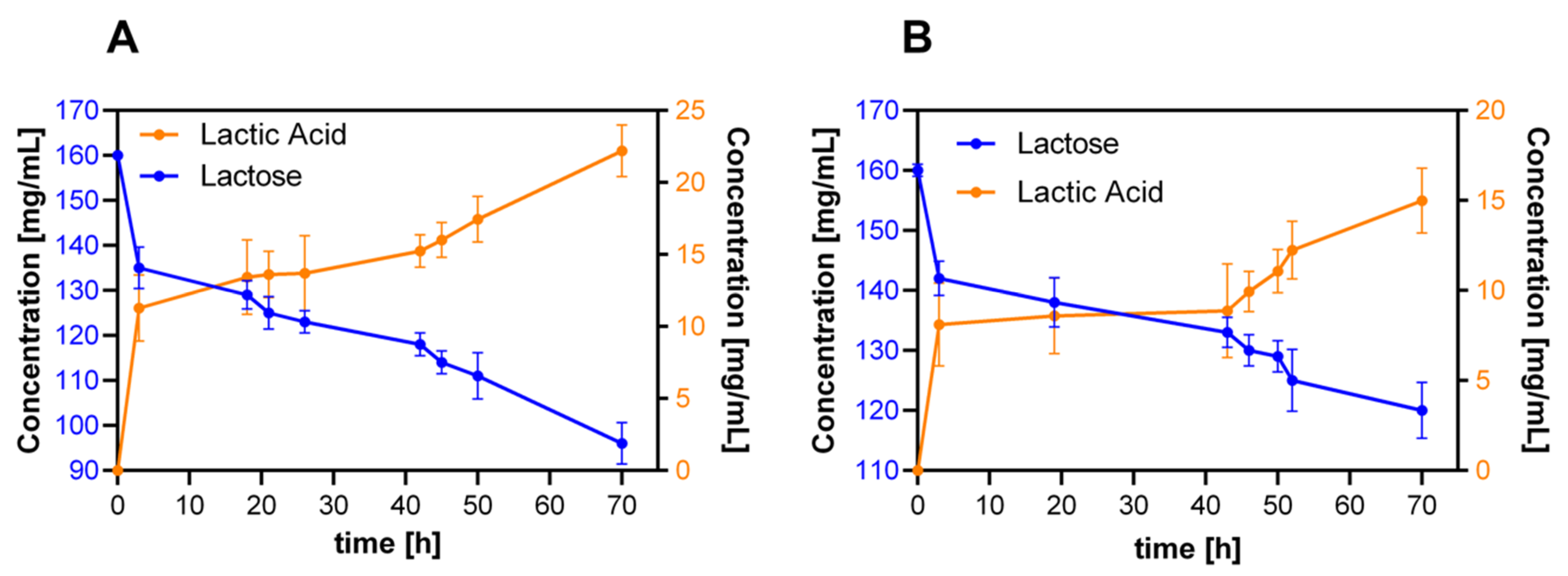

© 2020 by the authors. Licensee MDPI, Basel, Switzerland. This article is an open access article distributed under the terms and conditions of the Creative Commons Attribution (CC BY) license (http://creativecommons.org/licenses/by/4.0/).
Share and Cite
Patarroyo, J.L.; Florez-Rojas, J.S.; Pradilla, D.; Valderrama-Rincón, J.D.; Cruz, J.C.; Reyes, L.H. Formulation and Characterization of Gelatin-Based Hydrogels for the Encapsulation of Kluyveromyces lactis—Applications in Packed-Bed Reactors and Probiotics Delivery in Humans. Polymers 2020, 12, 1287. https://doi.org/10.3390/polym12061287
Patarroyo JL, Florez-Rojas JS, Pradilla D, Valderrama-Rincón JD, Cruz JC, Reyes LH. Formulation and Characterization of Gelatin-Based Hydrogels for the Encapsulation of Kluyveromyces lactis—Applications in Packed-Bed Reactors and Probiotics Delivery in Humans. Polymers. 2020; 12(6):1287. https://doi.org/10.3390/polym12061287
Chicago/Turabian StylePatarroyo, Jorge Luis, Juan Sebastian Florez-Rojas, Diego Pradilla, Juan D. Valderrama-Rincón, Juan C. Cruz, and Luis H. Reyes. 2020. "Formulation and Characterization of Gelatin-Based Hydrogels for the Encapsulation of Kluyveromyces lactis—Applications in Packed-Bed Reactors and Probiotics Delivery in Humans" Polymers 12, no. 6: 1287. https://doi.org/10.3390/polym12061287
APA StylePatarroyo, J. L., Florez-Rojas, J. S., Pradilla, D., Valderrama-Rincón, J. D., Cruz, J. C., & Reyes, L. H. (2020). Formulation and Characterization of Gelatin-Based Hydrogels for the Encapsulation of Kluyveromyces lactis—Applications in Packed-Bed Reactors and Probiotics Delivery in Humans. Polymers, 12(6), 1287. https://doi.org/10.3390/polym12061287






